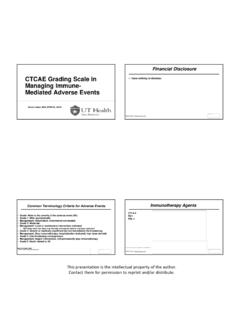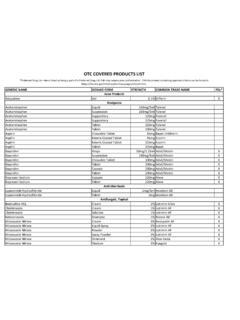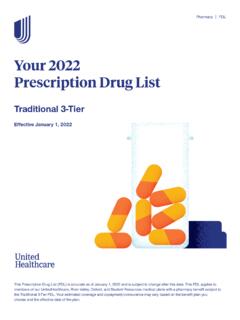Transcription of Emollients factsheet - Eczema
1 National Eczema Society Helpline: 0800 448 0818 Email: 1 Emollients factsheet Emollients are medical moisturisers used to treat Eczema . They are different from cosmetic moisturisers in that they should be unperfumed and do not have anti-ageing additives. Emollients have been used for over 5,000 years and they form an essential part of the therapy for all dry skin conditions, including atopic and contact Eczema . Emollients are safe and effective a good skin care routine using Emollients can soothe, moisturise and protect the skin, so helping to reduce the number of Eczema flares. The Emollients in this factsheet are available on prescription, and can also be bought over the counter from a are Emollients so effective? Dry skin is one of the main symptoms of Eczema . Changes in skin moisture levels cause a reduction in the barrier function, which in turn increases water loss. An impaired skin barrier also allows the penetration of substances which can irritate or cause an allergic reaction.
2 Itching is another major distressing symptom of Eczema , and produces an itch-scratch-itch cycle. Scratching leads to the release of histamine, a chemical in the body which makes the itching worse, and causes skin damage. Again, this allows irritants, allergens and bacteria to enter the skin. Emollients soothe and relieve the itch, producing an oily layer over the skin surface which traps water beneath it. The resulting restoration of the skin s barrier function by Emollients prevents the penetration of irritants, allergens and bacteria, thereby avoiding or reducing the development of Eczema and infection. Types of emollient There are many types of Emollients , which can be classified according to how they are applied/used. (See Tables 1, 2 and 3 for lists of products.) Please note: Prescribing of some emollient products, especially bath additives, will be discretionary, as recent research concluded that bath additives provided minimal or no additional benefit in the management of Eczema .
3 There 2is a sound evidence-base for the use of Emollients as leave-on products and soap substitutes, which can be prescribed or bought over the counter. Leave-on Emollients These are available as lotions, creams, gels, sprays and ointments, and are applied directly to the skin. Lotions contain more water and less fat than creams. Because of their high water content, lotions need to contain preservatives, which people can become sensitised to, although this is rare. Lotions spread easily and are cooling, but are not that effective at moisturising very dry skin. This is because they are not thick enough to repair the skin barrier. They are useful for hairy areas and weeping Eczema , or for quick absorption if time is short. Creams contain a mixture of fat and water, and feel light and cool on the skin. They are quite easy to spread over sore and weeping skin and are not greasy, so many people prefer them to ointments for daytime use. Like lotions, creams need to contain preservatives, which can cause sensitivity in some people.
4 Creams need to be used liberally and applied frequently (every 3-4 hours) to effectively repair the skin barrier and stop the skin drying out. Humectant creams (containing natural moisturisers such as urea and glycerine) effectively repair the skin barrier and need only be applied every 6 8 hours. Emollients factsheet National Eczema Society Helpline: 0800 448 0818 Email: 2 3 Hydrating gels Chemically speaking, gels are formed from molecules that make a three-dimensional network, which then traps other molecules in the spaces of the network. They are relatively light and non-greasy, despite having a reasonably high oil content. They should be applied every 3-4 hours. Some gels contain humectants, in which case, they only need to be applied every 6-8 hours. Sprays Currently two types are available: Dermamist (10% white soft paraffin in a base containing liquid paraffin and fractionated coconut oil, dissolved in butane) and Emollin (50% white soft paraffin and 50% liquid paraffin, dissolved in volatile silicone, which evaporates on application to the skin).
5 emollient spray is particularly useful for treating hard-to-reach places. Ointments are often stiff and greasy, and some people may find them cosmetically unacceptable. However, because they are very effective at holding water in the skin and repair the skin barrier well, they are useful for very dry and thickened areas, under wet wraps, or if a heavier emollient is required at night. They should be applied every 6-8 hours. Ointments should not be used on weeping Eczema . Ointments contain less water than other Emollients and therefore require fewer preservatives. Examples of ointments that are preservative-free are 50% white soft paraffin, white soft paraffin BP, yellow soft paraffin BP, Diprobase ointment, Zeroderm ointment, Hydromol ointment and Emollin spray. This makes them ideal for people who react to preservatives. Caution: It is very important not to put your fingers into pots of leave-on Emollients as there is a risk of contamination and spreading infection. If using a cream or lotion, a pump dispenser is best.
6 For ointments (and creams) in a tub, use a teaspoon to decant the amount of ointment/cream you need into another clean container before applying to your skin, and then discard any that you don t use. 4 Added ingredients Some Emollients contain added ingredients: Antimicrobials are found in some leave-on creams, lotions and assorted wash products. They destroy bacteria. Some people become sensitised to the leave-on forms if they are used for a long time. Humectants (propylene glycol, lactic acid, urea and glycerol) are found in some leave-on creams, lotions and a gel. They draw water into the epidermis (the outermost layer of skin) from the dermis (the second layer of skin). These only need to be applied every 6-8 hours. Anti-itch ingredients are found in a couple of creams in the form of lauromacrogols, a local anaesthetic which helps to relieve itch. Ceramides are found in some leave-on creams and lotions. They may re-establish the balance of fats necessary for the appropriate functioning of the skin barrier.
7 Oatmeal is found in one cream and lotion. It has anti-itch properties. Washing with Emollients (baths and showers) Cleansing the skin is integral to Eczema care in order to remove dirt and skin debris, which could cause infection. A daily bath/shower is recommended and it is important to always use an emollient for washing. Plain water without emollient will dry out the skin, whereas an emollient will cleanse the skin, reduce itching and repair the skin barrier by trapping moisture. The water should be tepid, as too much heat can aggravate Eczema . If you find that the water stings your skin, apply your leave-on emollient all over before getting into the bath and then gently wash it off. Ordinary wash products ( soap, wipes, bubble bath and other cosmetic creams and gels for the bath and shower) should be avoided as they are alkaline and contain detergent and fragrance which have the potential to dry and irritate the skin. Emollients factsheet National Eczema Society Helpline: 0800 448 0818 Email: 3 5 Soap substitutes should always be used for hand washing, showering and bathing.
8 You can either use an emollient product designed specifically for washing, or your usual leave-on emollient as a soap substitute simply apply it just before or during washing, showering or bathing, and then rinse it off. Soap substitutes may take a little getting used to as they don t foam like ordinary products, but they are nevertheless very effective at cleansing the skin. Bath and shower oils and additives are added to the bath water or some can be applied directly to the skin in the shower. They hydrate the skin, coating it with a film of oil, which traps moisture. Some bath and shower products have additional antimicrobial and anti-itch properties. Bath additives are readily available to buy but are unlikely to be prescribed, as recent research the BATHE study concluded that they provide minimal or no additional benefits when used in addition to standard Eczema treatments. Caution: Emollients make surfaces extremely slippery, so always use a bath/shower mat. Grab rails are also a good idea if you struggle to get out of the bath.
9 Use a baby bath support for babies under six months. Wipe the bath surfaces with paper towels or tissues to absorb excess oil. White vinegar is a good cleaning product for the bath. The bath may also be cleaned with an ordinary bath cleaner, but be careful to rinse it thoroughly. Warn other bath users that the bath or shower may still be slippery. Choosing the right emollient The best Emollients are the ones you like, because then you will use them more often. Dermatology departments sometimes provide samples of Emollients for people to try. Always test new products on a small area of unaffected skin for 48 hours in case you have a reaction. You may need to use different types of emollient on different parts of the body to obtain the best hydration and to restore the skin s barrier function to normal. You may also like to alternate between a lighter emollient 6during the day and during the warmer months, and a greasier one at night and when the weather is colder. Remember to additionally use your leave-on emollient as a soap substitute for washing.
10 Please note: Aqueous cream is no longer recommended, either as a leave-on emollient or as a soap substitute, as in addition to being a poor moisturiser it contains the ingredient sodium lauryl sulphate (SLS), which can irritate the skin and make Eczema worse. Several Emollients have been reformulated in recent years to remove SLS. Apart from aqueous cream and emulsifying ointment, no Emollients available on prescription in the UK still contain it. When and how to apply Emollients Emollients make the skin feel more comfortable and less itchy. They keep the skin moist and flexible, helping to prevent cracks. Unfortunately, they tend to be underused, as people often perceive them to be inactive moisturisers and do not understand why they are so important in controlling Eczema . When used correctly as a daily skin care regime, Emollients become effective active treatments . emollient therapy is not just about products but also about understanding how and when to use them. Applying Emollients can be time-consuming and tedious, but if you remember the enormous benefits, it will help you to persevere.





